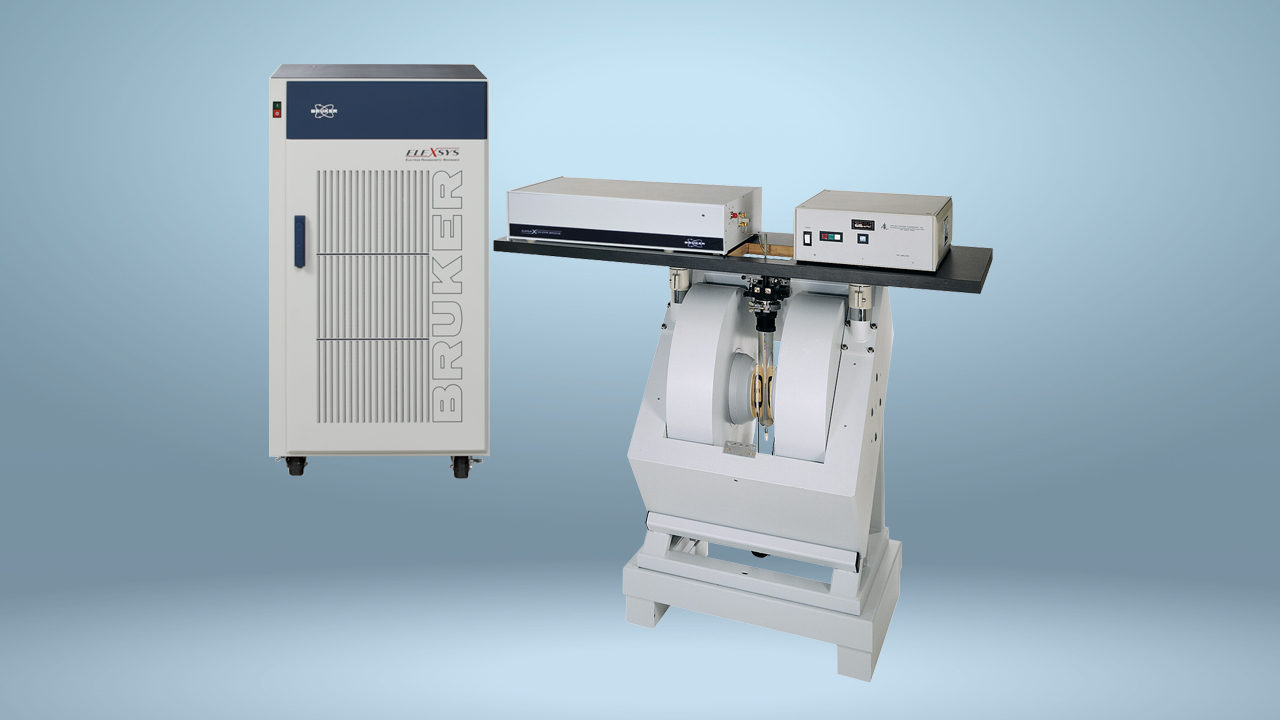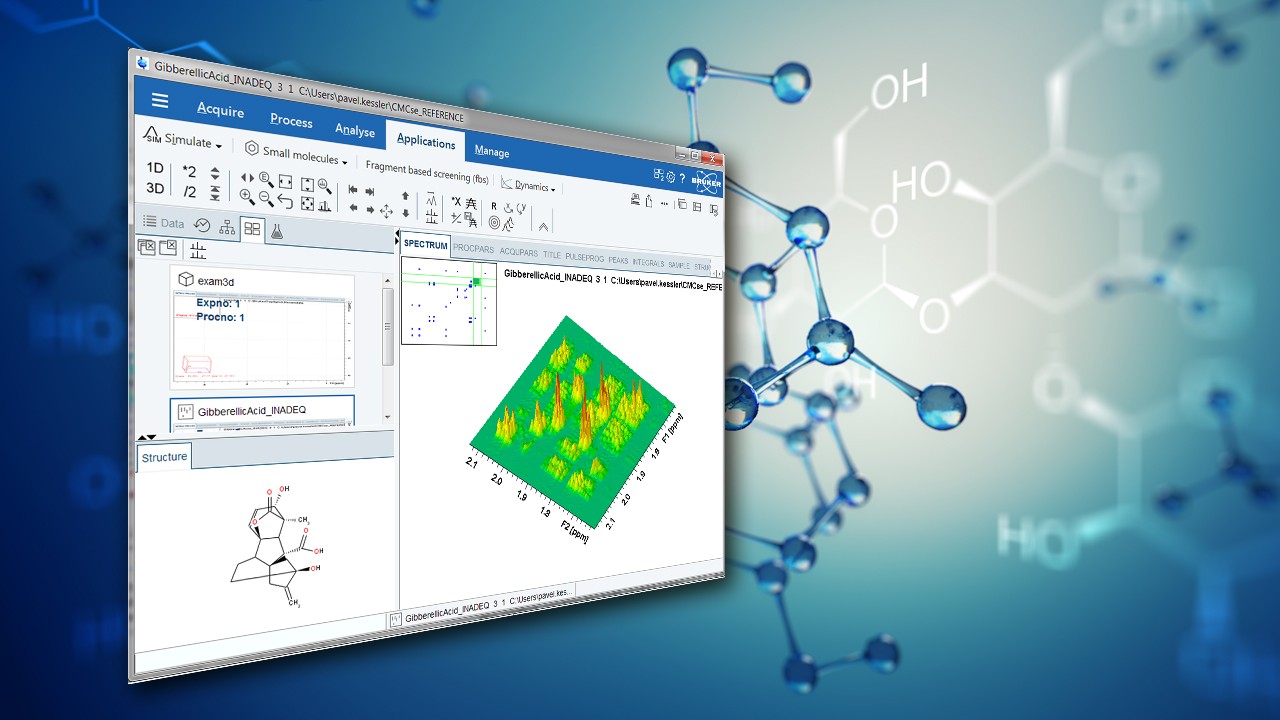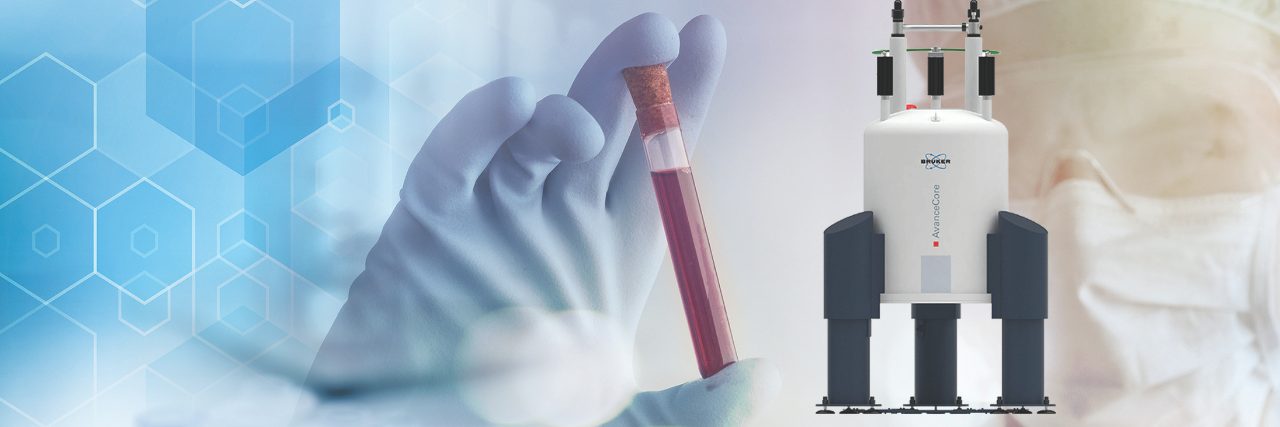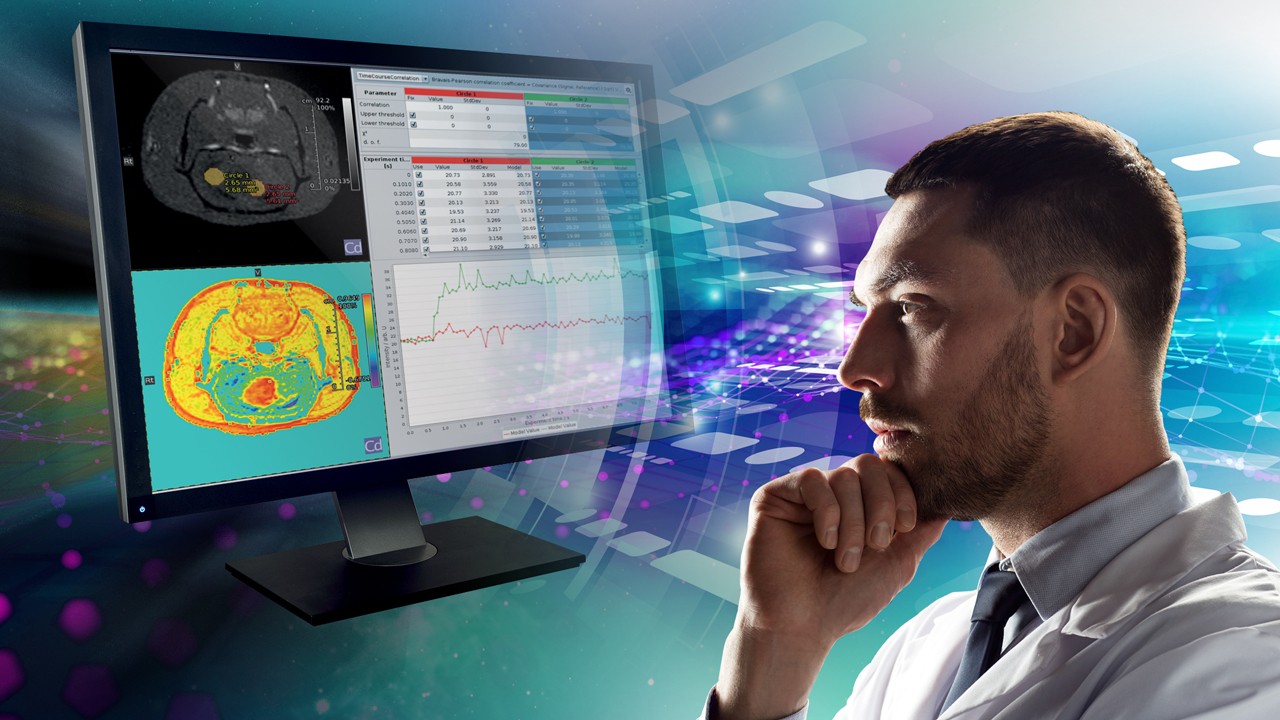磁気共鳴
磁気共鳴(MR)とは何か?
磁気共鳴は、電子常磁性共鳴(EPR)分光計や核磁気共鳴(NMR)に用いられる物理的効果であり、原子レベルで物質を研究し、分子構造に関する詳細な情報を得るために用いられます。
磁気共鳴分光法は化学、生物学、材料科学に応用され、研究と産業の両目的に役立っています。例えば、構造化学において分子構造や動的挙動の解明に重要な役割を果たし、これは医薬品開発や材料科学において極めて重要です。
さらに、磁気共鳴画像法(MRI)と時間領域核磁気共鳴(TD NMR)も磁気共鳴の応用例です。MRIは非侵襲的に内臓器官や組織の詳細な画像を提供し、疾患の早期発見と管理を支援します。TD NMRは分子構造・ダイナミクス・相互作用に関する知見を提供し、医薬品、高分子、食品産業、環境科学などの分野で品質管理や構造解析に活用されています。
ブルカーは、EPR分光計、NMR分光計、前臨床MRI装置の主要サプライヤーとして、これらの技術を絶えず進化させてきました。
磁気共鳴の世界では、原子の構成要素が磁場に曝されると、振動する磁場によって擾乱され、電磁信号を発生させることで反応します。このプロセスが原子核を対象とする場合、「核磁気共鳴(NMR)」と呼ばれ、電子に焦点を当てた場合は「電子スピン共鳴(ESR)」または「電子常磁性共鳴(EPR)」となります。ESRは1944年にロシアの物理学者エフゲニー・コンスタンティノヴィチ・ザヴォイスキーによって初めて観測され、この分野における多くの重要な発見の始まりとなりました。2年後、NMRはフェリックス・ブロッホとエドワード・ミルズ・パーセルが率いるチームによって米国で独立して観測され、この画期的な成果により彼らは1952年のノーベル物理学賞を受賞しました。これは磁気共鳴が科学技術に与えた深遠な影響を浮き彫りにする出来事でした。
核磁気共鳴(NMR)分光法の原理
NMR分光法では、分析対象の試料を強力な磁場内に導入します。試料中の原子核は、分光器内の磁場と相互作用するために「non-zero nuclear spin」と呼ばれる特定の量子力学的性質を有している必要があります。水素など多くの重要な核がこの性質を持ち、NMRによる分析が可能です。試料物質がNMR分光器の磁場内に導入されると、試料中の核スピンは磁場と平行に揃います。NMR分光計では、試料は高周波(RF)コイルに囲まれ、このコイルを用いて試料に1つ以上のRFパルスを印加できます。RFパルスは試料中の核スピンを励起します。この励起に対する応答として、RFコイル内で電磁応答が生じ、これには試料中の核に関する情報が含まれます。これにより、例えば分子の構造を推定することが可能となります。核スピンの共鳴周波数は磁場の強さに依存します。
NMRで一般的に用いられる磁場強度では、プロトンは数百メガヘルツ(MHz)の周波数で共鳴します。驚くべきことに、これにより研究者は存在する原子の種類だけでなく、分子内での位置も特定でき、その三次元構造に関する知見が得られます。
ブルカーはNMR分光法の開発と商業化において主導的な役割を果たしてきました。ブルカーは1960年、ドイツ・カールスルーエにて、NMR技術の商業的可能性をいち早く認識したドイツ人物理学者兼起業家ギュンター・ラウキエン博士らによって設立されました。彼の先見性がブルカーをNMR革新の最前線に押し上げ、技術進歩と共に絶えず進化を遂げてきました。NMR分光法は継続的なブレークスルーを経験しました。
特に顕著な技術的成果としては、フーリエ変換NMR(FT-NMR)の採用、磁場強度が絶えず向上する超電導磁石の活用、多次元NMRが挙げられます。今日、NMRは様々な科学分野において依然として必須のツールであり、分子の解析において比類のない精度を提供し続けています。
フーリエ変換核磁気共鳴(FT-NMR)
FT-NMRでは、試料物質に非常に短く比較的強いRFエネルギーパルスを照射し、試料中の全スピンを同時に励起します。この急速な励起により重なり合った共鳴信号が生成され、分光計によって記録されます。これらの信号はフーリエ変換(FT)と呼ばれる数学的解析処理を受け、時間領域データを周波数領域データに変換し、解析しやすいスペクトルとして表示可能となります。この手法は複雑な分子組成を分解できる点が特徴であり、分析実験室のワークフロー効率を大幅に向上させます。FT-NMR分光計が生成するスペクトルは通常図1のように、科学者が分子構造の推定や混合物中の不純物検出に活用できます。この能力は品質管理(製品の一貫性確保)や医薬品開発(精密な分子解析による高効能化合物の創出)など多分野で不可欠です。さらにFT-NMRは、化学研究、材料研究(特にエネルギー貯蔵分野)、生物学(分子の三次元構造理解が不可欠な分野)で広く活用されています。その汎用性により、研究者は静的・動的化学特性の両方を調査でき、基礎科学の進歩に大きく貢献しています。
FT-NMRは1960年代にスイスの物理学者リヒャルト・エルンストによって開発されました。彼は高分解能NMR分光法の開発における画期的な貢献により、1991年にノーベル化学賞を受賞しました。今日に至るまで、FT-NMR分光法は最も広く用いられている手法であり、その理由は主に、高分解能データを迅速かつ確実に提供できる能力にあります。
高磁場化による高分解能化
より強力な磁場を使用することでNMRの感度が向上し、スペクトルの分解能が向上します。現在、ほとんどのNMR分光計では、極低温に冷却された超電導磁石を用いて強力な静磁場を生成しています。世界最強クラスの磁石(磁場強度30テスラ級)の一部はNMR分光計に使用されています。小型でコンパクトな卓上型NMR分光計では、永久磁石が頻繁に使用されます。
多次元核磁気共鳴(NMR)
多次元NMRは、特殊なパルスシーケンスを用いて複数の周波数軸で定義されるデータを得る一連のNMR手法であり、NMRスペクトルの分解能と情報量を向上させます。多次元NMR分光法は、タンパク質、DNA、RNAなどの生体分子の構造決定の基礎を成すだけでなく、材料科学においても日常的に用いられています。スイスの物理学者クルト・ヴュートリッヒは、溶液中の生体高分子の三次元構造を決定するためのNMR分光法の開発により、2002年のノーベル化学賞を受賞しました。
NMR分光法について詳しく知る:
What is NMR: 1D NMR
What is NMR: 2D NMR
電子常磁性共鳴(EPR)分光法
電子常磁性共鳴(EPR)は、電子スピン共鳴(ESR)とも呼ばれ、フリーラジカル、遷移金属イオン、希土類イオン、材料中の欠陥など、不対電子を持つ分子や原子を研究するために用いられる分光法の一種です。汎用性が高く非破壊的なため、固体・液体・気体のいずれにも適用可能です。EPRは試料中の不対電子を明確に検出・定量できる唯一の手法でもあり、多様な科学分野における研究と実用応用の双方において、極めて貴重な分析資源となっています。
EPR分光計の種類
電子常磁性共鳴(EPR)分光計には主に2種類あり、それぞれ不対電子を持つ試料を分析する独自のアプローチを提供します:連続波(CW)EPRとパルスEPRです。
CW EPRでは、磁場を変化させながら試料を一定の周波数のマイクロ波に曝露します。これにより、磁場変動に伴うマイクロ波反射の変化を観測することで試料応答の定常状態測定が可能となり、スペクトルが取得されます。この手法は試料中の不対電子スピンの発生源を特定するのに有用であり、電子スピンと環境(超微細相互作用など)との相互作用に関する手がかりを提供します。
対照的に、パルスEPRはNMR技術と同様に動作し、試料は一連のマイクロ波パルスに曝され、これがスピン遷移を刺激します。これらのパルスに対する電磁応答は、フーリエ変換を用いて時間領域または周波数領域で捕捉・解析されます。 パルスEPRの主な利点は、緩和時間、詳細な超微細構造、双極子結合の直接測定など、従来のEPRでは容易に得られない情報へのアクセスにあります。スピンラベルを有する生体分子における過渡状態を測定して動的情報を得たり、タンパク質部位における低分子結合効果を調べたりすることが可能です。
CWとパルスEPRの選択は、測定精度や必要とする情報の種類といった具体的な研究要件に大きく依存します。EPR分光器技術の継続的な進歩と革新により、装置の柔軟性と精度が向上し、化学、材料科学、医学など多様な分野における不可欠なツールとしての地位を確固たるものとし、さらなる探求と発見への道を開いています。
EPR分光法の出現
1944年にエフゲニー・ザヴォイスキーによって発見されたEPRは、NMRと類似していますが、原子核ではなく電子のスピンを励起させることに基づいています。EPRにおける電磁信号の周波数はNMRよりもかなり高く、典型的には数十から数百ギガヘルツ(GHz)の範囲、すなわちマイクロ波帯にあるため、試料内のスピンを励起するにはマイクロ波源が必要となります。
商用EPR装置は新たな応用分野の要求変化に対応して進化を続けてきました。ブルカーは1960年代にワイル教授との共同開発によるER420 EPR分光計を発売し高磁場EPR市場に参入すると、直感的でコスト効率に優れコンパクトな装置の必要性をいち早く認識しました。これは非専門家向け自動チューニング分光計の画期的な開発に向けた第一歩でした。1989年、ブルカーは世界初の完全コンピュータ制御EPR分光計を発表。1992年には産業用途を支援する卓上型EMS104を発売しました。
パルスフーリエ変換(FT)電子スピン共鳴(EPR)分光計の開発への関心は、HYSCORE実験の開発者であるピーター・ホーファーによって主導されました。彼は後に2017年に英国王立化学協会からブルカー賞を受賞しました。
電子分光法における最新動向
ブルカーのコンパクトな卓上型EPR分光計「Magnettech ESR5000」の導入により、EPRの応用範囲は大幅に拡大し、現在では食品分析、医療機器、医薬品研究などで広く活用されています。ブルカーはさらに、世界最高周波数263 GHzを誇る商用EPR分光計「ELEXSYS E780」を導入し、ハイエンド分野での革新を続けています。E780が提供する高周波数により、単一試料中の複数の常磁性種を区別するために必要なg因子分解能が実現。従来低周波数では得られなかった情報が容易に取得可能となり、様々な化学プロセスに関する重要な知見が得られるようになりました。
ブルカーの技術革新により、ラピッド・スキャンEPRアクセサリが導入されました。この革新的な装置は、EPR測定において優れた時間分解能(マイクロ秒領域)を実現し、信号対雑音比を向上させるとともに、取得時間を短縮します。
EPRの応用
EPRは、生化学、生物物理学、電子機器・エネルギー貯蔵用新素材の開発、量子情報科学(QIS)、環境科学など、幅広い分野において世界中の研究者によって利用されています。
フリーラジカルは短命であることが多いが、多くの重要な生物学的・化学的プロセスにおいて決定的な役割を果たしています。その短命さにもかかわらず、これらの高反応性分子は周囲に損傷を与える可能性があり、がん、アルツハイマー病、心血管疾患を含む様々な疾患に関与し、老化プロセスと密接に関連しています。EPR分光法が持つフリーラジカルを正確に検出・定量する能力は、これらのプロセスのメカニズムに関する知見を提供し、関連する健康障害と戦う新たなアプローチを開発するための貴重な情報を研究者に提供します。
生化学において、EPRはフリーラジカル反応と反応速度論に関する知見を提供することで、低分子化合物の構造解明と定量化に極めて重要な役割を果たします。より広範な分子レベルでは、タンパク質、DNA、RNAなどの高分子における金属中心、配位子、基質結合部位の同定を支援すると同時に、タンパク質内の重要な電子移動経路やアミノ酸由来ラジカルの観察を可能にします。 さらに、パルスEPRはスピン標識法を用いることで、生体分子内の異なる部位におけるスピン間距離の測定を可能にし、機構的イベントに応じた立体構造変化や一過性状態の解明に寄与します。
量子情報科学(QIS)分野では、科学・工学研究者による量子力学の採用拡大に伴い、パルスEPR技術の復活が確認されています。量子ビット(qubit)として数多くの材料が探索されており、量子ビットはQISにおける基本情報単位です。パルスEPRは、スピン特性への直接アクセス、マイクロ波パルスによるコヒーレント制御、さらには量子論理演算の実行さえ可能であることから、電子スピンに基づく分子量子ビットの研究において不可欠な技術であることが実証されています。
電子工学およびエネルギー貯蔵の分野において、EPRは電気化学的条件下での材料挙動に関する貴重な知見を提供します。特に電池開発においては、充放電サイクル中に電極材料の劣化を誘発するフリーラジカルを検出する上で極めて重要であり、これによりより効率的な電極材料の開発が可能となり、電池の安定性と効率が向上します。半導体材料の欠陥も、光電子工学、太陽光発電、量子コンピューティング、センシングなどの分野での応用により、材料研究の分野で注目を集めています。EPR分光法を用いることで、欠陥の同定、電子構造の決定、触媒プロセスのモニタリングなどが実現可能です。環境科学分野では、遷移金属イオンやラジカルなど不対電子を有する系の特性評価を通じて、EPRは持続可能なエネルギー開発に大きく貢献しています。この能力により、将来のエネルギー変換技術の発展に不可欠な複雑な多電子触媒サイクルの深い理解が促進されます。
EPR分光法について詳しく知る:
強い磁場に曝された後のエネルギーレベルの変化を利用する磁気共鳴法は、いくつかの強力な分析研究ツールの基礎となっています。磁気共鳴分光法(MRS)には、核磁気共鳴(NMR)や電子常磁性共鳴(EPR)などの様々な関連技術が含まれており、研究、臨床、産業界での様々な応用が期待されています。
この技術の非侵襲性、非破壊性は、生きた細胞や組織の研究だけでなく、溶液や体液の詳細な分析を可能にします。磁気共鳴分析法を組み合わせることで、機能の情報と解剖学的情報の両方を提供することができ、両者の関係を決定することができます。
健康な状態と罹患者の尿と血液サンプルのMRS分析により、様々な疾患の発症リスクを評価したり、特定の化学療法に対する治療反応を予測したりするためのバイオマーカーを同定することが可能になりました。
ブルカーは、NMR、時間領域(TD)NMR、ESR、前臨床磁気共鳴イメージング(MRI)などの磁気共鳴分光装置のマーケットリーダーです。
また、ブルカーはNMRやMRI向けの超電導磁石や超高磁場磁石のトップメーカーでもあります。
磁気共鳴画像法(MRI)
磁気共鳴画像法(MRI)は1970年代に核磁気共鳴(NMR)の基礎原理から発展し、当初は臨床診断に革命をもたらしました。その後まもなく、これらの機能を小動物モデルへ拡張するため前臨床MRIシステムが開発され、生物医学研究における生体内の画像化が可能となりました。その後数十年にわたり、磁石技術、傾斜磁場システム、RFコイル、ソフトウェア設計の進歩により空間分解能と時間分解能が大幅に向上し、MRIはトランスレーショナルリサーチの基盤技術として確立されました。
前臨床MRIでは、生体試料を強力な静磁場内に配置します。組織内の水素原子核はこの磁場に整列します。被験体を囲むコイルから送られる短時間の高周波(RF)パルスが、これらの原子核の整列を一時的に乱します。スピンが平衡状態へ戻ろうとする際に弱いRF信号を放出し、同一または追加のコイルがこれを検出します。空間情報は急速に切り替わる磁場勾配によって符号化され、再構成アルゴリズムが受信信号を詳細な画像へ変換します。異なる組織タイプや生理学的プロセスは、磁場とRFパルスに対して固有の応答を示します。これにより、緩和時間(T1、T2)に基づく定量的コントラスト、拡散、灌流など、様々なコントラストメカニズムが可能となります。血中酸素レベル依存性(BOLD)信号などの機能的指標も画像化に寄与します。これらの技術により、解剖学的構造の可視化、組織特性の評価、特異性の高い機能的活動モニタリングが可能となります。高磁場と特殊コイルにより、小動物やその他のモデル生物に適した高解像度画像化が実現されます。
非侵襲的で電離放射線を使用しないため、前臨床MRIは同一コホートを長期にわたり追跡する縦断的研究を可能にします。これにより生物学的変動性が低減され、3R原則との整合性が促進されます。その多パラメトリック特性により、単一セッションで解剖構造・機能・代謝を同時に捕捉できます。この特性は神経科学、腫瘍学、心臓病学、呼吸器学などの分野における標的検証、バイオマーカー開発、治療評価を容易にします。標準化されたワークフローと定量プロトコル、さらに陽電子放出断層撮影(PET)などの他モダリティとの統合により、再現性、感度、トランスレーショナルな関連性がさらに向上します。これらの機能は、研究者が前臨床所見と臨床エンドポイントを結びつけるのに役立ちます。
磁気共鳴 – 多用途な分析技術
ブルカーは、MRアプリケーションと製品開発における豊富な経験に基づき、ライフサイエンス、材料科学、その他の分野における先端研究で使用される計測機器を提供しています。これらのハイエンドソリューションに加え、ブルカーの卓上型MR製品群は、応用市場および産業市場における品質管理の効率化を推進しています。
この汎用性により、MRは環境分析、法医学、食品品質保証、農業といった主要分野において不可欠なツールとなっています。この技術は化学、エンジニアリング、製造など幅広い産業用途に展開されています。特に、プラスチック・ポリマー、医薬品・バイオ医薬品、エネルギー関連産業は、MR技術が提供する精密かつ洞察に富むデータから大きな恩恵を受ける可能性があります。この適応性は、多様な応用分野における革新の促進と一貫性の維持においてMRが果たす中核的役割を強調しており、ブルカーが最先端の磁気共鳴ソリューションを通じて研究と産業効率の向上に注力している姿勢を示しています。
磁気共鳴 - 多様な応用分野における進歩を推進
ライフサイエンス研究
生命科学と医薬品の急速に変化する分野において、高度な研究ソリューションは発見の加速と分析能力の拡大による生産性向上に不可欠です。NMRやEPR分光法などのツールを活用することで、研究者は分子構造とダイナミクスに関する前例のない知見を得られ、最終的に創薬プロセスを強化できます。これらの技術は複雑な生物学的システムを理解するために不可欠な精密データを提供し、新たな治療法や個別化医療アプローチの開発を促進します。MR技術が提供する包括的なデータは、イノベーションを推進するだけでなく、実験室ワークフローを最適化し、科学者が効果を高めつつ開発期間を短縮した新規治療法・介入法の開発に集中することを可能にします。さらに、MR技術の継続的な進歩により、研究者はライフサイエンス・医薬品研究における最も困難な課題に取り組む準備が整い、医療成果に革命をもたらすことが期待されています。
材料科学研究
材料科学分野は急速に進化し、私たちの生活様式に大きな影響を与える産業・技術革新のペースを加速させています。ハイテク材料の革新は、医療科学やヘルスケアにおいて極めて重要な生体材料の開発など、様々な分野で画期的な進歩をもたらしています。これらの材料は、治療の有効性と安全性を高める薬剤送達システムのための最先端ソリューション創出に不可欠です。材料科学の新たなフロンティアであるナノテクノロジーは、特に電池開発に焦点を当て、エネルギー生産・貯蔵ソリューションの改善において極めて重要な役割を果たしています。これは携帯型技術への需要増大を支え、デバイスの効率性向上、長寿命化、環境持続可能性を確保する上で不可欠です。さらに、この分野の進歩は産業全体における持続可能な実践を強化し、現代の差し迫った地球規模の課題に対応する革新的な応用への道を開いています。
産業用途
ブルカーは、様々な産業分野における生産性向上を支援するため、幅広い試験・品質管理ソリューションを提供しています。MR分光法は、安全性と性能において精度と信頼性が極めて重要な航空宇宙や自動車産業などの機械・材料試験において中核的な役割を果たします。建設分野ではMRアプリケーションが材料の耐久性と安定性を保証し、化学・塗料産業では最適な配合と耐久性を実現するための組成分析を支援します。ガラス・セラミックス・金属分野では、MRによる構造・組成の知見が製造プロセスの進歩に貢献します。化粧品・電子産業では、MR分光法が製品成分の詳細分析を提供し、品質保証と業界基準への適合を実現します。さらにエネルギー・ガス・電力分野では、多様な条件下での材料安定性・性能監視に重要な役割を果たします。プラスチック・ポリマー産業では、機械的特性と耐久性を向上させた材料開発にMR技術を活用しており、これは医療機器の革新にも同様に適用可能です。医療機器分野では、安全性と有効性のために精密な材料特性評価が不可欠です。
環境
環境課題が深刻化する中、特に残留性有機汚染物質(POPs)やマイクロプラスチックの増加に伴い、高度な分析ソリューションの必要性が急務となっています。MR技術は、微量レベルの汚染物質を検出・分析する精密な手法を提供し、これらの課題に対処する極めて効果的なツールとして際立っています。ブルカーのMRソリューションにより、環境科学者は空気、水、食品、土壌など様々な媒体における農薬、重金属、有機汚染物質の徹底的な評価を実施できます。このレベルの検出能力は、汚染物質が危険なレベルまで蓄積する前に特定することを可能にするため、生態系と公衆衛生を守る上で極めて重要です。さらに、MR技術の汎用性は多様な環境状況での応用を支え、拡張性のあるソリューションを提供します。迅速かつ正確な汚染評価を促進することで、MR技術は規制機関や産業が効果的な緩和策を実施するのを支援し、世界的な環境保全活動において重要な役割を果たしています。
フォレンジックと国境管理
MR技術は、法科学において最小限のサンプルから広範な情報を抽出することで貴重な知見を提供する内容豊富な分析手法です。この能力は特に薬物鑑識において有益であり、MR技術は新規向精神薬(NPS)の特定に優れ、新たな薬物脅威に対処する法執行機関の能力を強化します。刑事鑑識の分野では、MRが微量証拠の精密分析を担う重要な役割を果たします。さらに税関・国境管理当局は、違法物質や密輸品の検出におけるMRの効率性を活用しています。こうした詳細な鑑識評価を可能にするMR技術は、法的枠組みの執行を支え、正義の実現と公共の安全確保に寄与しています。
食品品質管理
ブルカーの分析ソリューションは、食品サプライチェーン全体における製品品質と安全性を維持するための品質管理(QC)を支援し、食品の真正性を確保することで、世界の食品生産業界における食品詐欺の脅威を防止し、消費者が偽装・誤表示製品から保護されるよう貢献します。絶えず変化する市場環境において、食品安全への懸念が継続的に生じる中、消費者の健康を損なう可能性のある汚染物質や偽装物質を特定するための堅牢な試験手法が求められており、このレベルの精査が不可欠です。最先端の磁気共鳴分光法を導入することで、製造業者は有害物質を正確に検出でき、製品が安全基準を満たすことを保証します。この技術は食品の起源と組成の検証にも役立ち、消費者が摂取する食品に関する知識をますます求める中、企業が透明性を維持し消費者との信頼を構築するのを支援します。結果として、このような包括的な検証プロセスは公衆衛生を保護するだけでなく、グローバルな食品サプライチェーンの完全性を維持し、消費者が選択するブランドへの信頼を強化します。
農業および動物飼料
MRは、飼料、ペットフード、穀物・種子・糖作物をはじめとする農業サンプルの栄養価を保持しつつ、日常的な栄養成分分析を高度かつ簡便に行う手法を提供します。さらに潜在的な毒素の特定においても重要な役割を果たし、動物の栄養要求を一貫して満たすことで、最適な健康状態と生産性の向上を促進します。さらにMRは汚染物質や毒素を早期に検出することで、農産物の安全性と品質維持に貢献し、厳しい業界基準や規制への適合に不可欠なツールとなっています。このプロセスでは精密なMR分光法を用い、栄養組成と潜在的危険性に関する正確かつ信頼性の高いデータを提供します。これにより、農家や生産者は飼料配合や品質管理に関する情報に基づいた意思決定が可能となります。栄養検査へのMR導入は、動物の健康保護に寄与するだけでなく、農業実践全体の効率性と持続可能性を向上させます。資源を責任を持って使用しながら生産量を最大化し、生態系のバランスを維持することを保証するのです。
磁気共鳴が顧客調査にどのように役立っているか
ブルカーは、画期的な研究の最前線に立つ世界中の顧客と提携し、協力しています。ブルカー機器の高度な機能を活用することで、これらの研究者は科学的理解の限界を押し広げる新たな知見を明らかにしています。食品認証の分野では、ブルカーの装置が食品の真正性と品質を精密に判定し、世界的な課題である食品詐欺対策と消費者安全の確保に貢献しています。さらに、MR技術はCOVID-19研究において重要な役割を果たしており、研究者はこれを利用してウイルスと宿主の相互作用を分析し、治療戦略の開発を加速させています。持続可能エネルギー分野では、MRシステムが新素材に関する重要なデータを提供し、効率性と環境持続性を高める次世代エネルギー貯蔵ソリューションの開発を支援しています。また、疾患治療においては、MRが様々な病態の分子経路に関する比類のない知見を提供し、より効果的で標的を絞った治療法の設計を促進しています。この協働アプローチは、ブルカーの最先端研究への影響力を強化するだけでなく、多様な科学分野におけるイノベーションを促進しています。
磁気共鳴技術に関する知識を深める
ブルカーは、NMRおよびEPRを利用する研究者が科学を推進できるよう、包括的なトレーニングコースと教育プログラムを提供することに尽力しています。対面式およびオンラインコースは、当社の磁気共鳴専門家チームが指導し、あらゆるスキルレベルの科学者がNMRおよびEPR技術を習得できるよう詳細な解説を提供します。初心者から経験豊富な専門家までを対象に、基礎理論、高度な分析技術、MR技術の最新動向を網羅しています。参加者は最先端のMR装置を用いた実践的な経験を積み、独立した研究を行うための実践的スキルと自信を高めます。理論的な指導と実践的な応用を統合することで、ブルカーは参加者がそれぞれの分野でMR技術を活用できる能力を確実に身につけ、科学と産業における革新を促進し、進歩を加速させます。こうした教育活動を通じて、ブルカーは知識の向上を支援するだけでなく、現代の科学的な探究における複雑な課題に効果的に取り組むための準備を整えます。
NMRトレーニングコースおよび教育プログラム
Bruker’s ブルカーの NMRトレーニングコースは、核磁気共鳴の基礎から高度な分析技術の習得に至るまで、研究者に包括的な教育機会を提供します。これらの入念に設計されたコースは、NMR理論に対する深い理解を伝授し、参加者がシステムを効果的かつ革新的に活用するために必要な知識を身につけることを目的としています。様々な応用分野に踏み込んだ豊富なカリキュラムのもと、参加者はブルカーの経験豊富なトレーナー陣による指導を受けます。トレーナーは教室に豊富な専門知識と洞察をもたらします。このダイナミックな学習環境により、研究者は各自の研究ニーズに合わせた個別指導を受け、NMR装置とソフトウェアの可能性を最大限に引き出すことが可能となります。化学、材料科学、その他の科学分野における応用を目的とする場合でも、ブルカーの教育プログラムは科学者がNMR技術を活用し、発見と革新の限界を押し広げることを支援します。
EPRトレーニングコースおよび教育プログラム
ブルカーのオンラインおよび対面式EPRトレーニングプログラムでは、初心者から上級ユーザーまで、EPRシステムを最大限に活用するために必要なスキルと知識を習得できます。これらの教育コースは、材料科学から生物系に至るまで、幅広いEPR応用分野を網羅しています。












